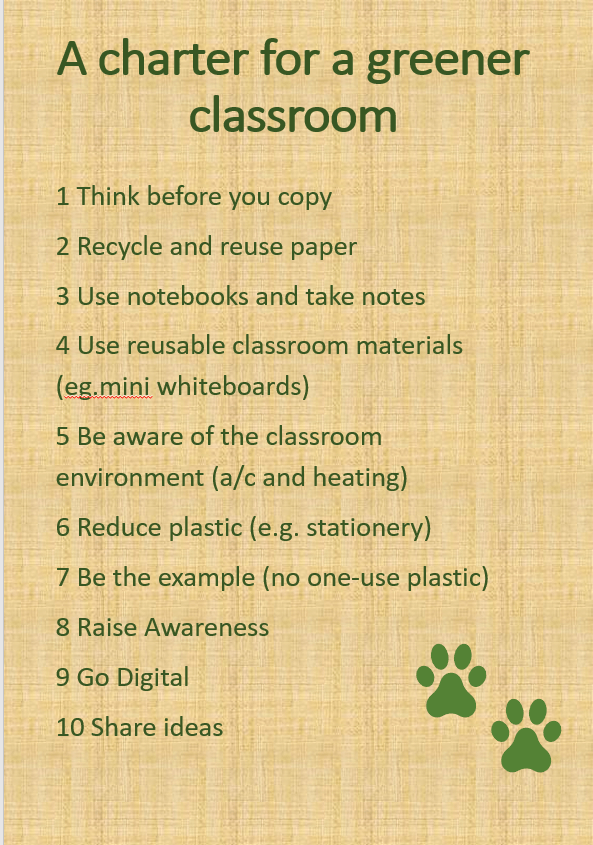
Teacher training and its ELT footprint
The ELT Footprint facebook group recently published a charter for a greener classroom. (Here is a link to the document and conversation that led to the final version). This charter, the shorter version of which you see below, asks us to be more thoughtful and active in how we reduce our carbon, paper and plastic footprint on the environment. As most English language teaching starts in the training classroom, let’s consider how this charter can develop positive attitudes, awareness and practices related from the get go.

I think this charter could be used on day one of any teacher training course to guide and provoke action amongst trainee teachers. The image below is a poster version we can display in centres, near the photocopier, in training rooms and offices. It can be part of the introduction to the course input sessions and be referred to throughout the course by tutors and school staff.
Trainee teachers are usually under a reasonable amount of stress and their environmental footprint may not always be at the forefront of their mind. It is up to teacher trainers to help create awareness and green habits as part of the support on the course. Hopefully, this will then create a greener approach to teaching English when the trainees go off and work in different contexts.
I’ve been a teacher trainer for over ten years now, working on Certificate and Diploma level courses. The course I manage at the moment is a blended Dip TESOL course so I have thought about how we could impact on trainees pre-service and in-sevice, during online and face-to-face courses to build a separate and complimentary teacher training charter. We need to be the example mentioned in number 7 above!
In the spirit of the ELT Footprint group, we would love to add your ideas to my lists below. Training happens in a multitude of contexts, each with their own challenges relevant to how ELT impacts on our environment. Let’s build a training community where we step up and tackle climate problems to create a positive climate footprint in the ELT profession.
Face to face teacher training.
Pre-service:
- Practice what we preach and keep handouts to an absolute minimum, in fact let’s get rid of them entirely.
- Don’t give out shiny, branded non-recycled notebooks on day one but encourage trainees to take notes on a laptop, phone or tablet. If trainees do like to take hand-written notes, encourage them to use one notebook and try to source recycled notebooks you can give them.Send them any important documents from input sessions electronically.
- Get teachers used to planning lessons which require no handouts for students. Build this into our training sessions on lesson planning and discuss it in lesson planning support sessions.
- Make environmental impact part of the discussion when giving input sessions on using course books, ELT resources and event methodology.
- Include sessions on learner training and include a focus on note taking- can we help students be mindful of how much paper and other materials they use? Can we give them recycled paper to make notes on? There are some nice ideas on this in the existing charter for the classroom [link again].
- Encourage discussion about our role as English language teachers and raising awareness of environmental issues. Maybe this can be an interesting part of culture training?
In-service:
- In my context, teachers come from all over the world to do part of their assessment on the Diploma. This in itself is problematic for obvious reasons. Things are changing as we move towards video assessments of lessons. However, the gateholders of qualifications such as Trinity and Cambridge still insist, as far as I know, on face-to-face assessments of final teaching observations with their examiners. As course providers, let’s put pressure on these institutions to change this.
- All of the above but from a more reflective perspective! When trainees come with existing experience, help them to question their practices and those of other teachers in their context.
- Open up discussions about the way the ELT profession impacts on the environment.
Online teacher training.
Teacher training and development is increasingly taking place online as platforms for video interaction improve. Teacher trainers can provide guidance, lead input sessions, observe lessons, discuss CPD, mentor and well just about anything via a mobile device or PC. This is a game changer in terms of cutting the training carbon footprint.
However, there is still room for an increased focus on the environment in online teacher training. It is not part of any criteria for teacher development or assessment as far as I know (you may be ahead of the game and have integrated discussion on this). I am not suggesting we start measuring a teacher’s effectiveness in the classroom based on how eco friendly they are, but I do think we can make it part of how we manage online training. Once trainers have it in mind they should bring it into the discussion, they can do as they see fit so it’s relevant to their context. Here are some things that I do:
- When giving feedback on lesson plans in our online Dip TESOL course, I often point out ways the lesson could cut back on printed resources.
- In our online classroom, we provide easy to embed articles so teachers don’t have to print anything. I have also started building a library of articles online using Google drive.
- We encourage teachers to sell books from the reading list to each other locally to avoid buying new ones (sorry authors).
Here are some more things I am considering for the future:
- Do some learner training about how to organise learning digitally- there are lots of apps out there! This might cut down on printing and excessive note taking.
- Do some research with the trainees on what they think could reduce our environmental footprint.
So, that is the long version of my own personal training charter. Below is a shorter, poster version.
- Help teachers question their practice.
- Reduce paper handouts on teacher training courses.
- If you give trainees notebooks, source recycled, locally printed options.
- Develop good practice in lesson planning support.
- Make ELT’s environmental impact part of input sessions.
- Discuss a teacher’s role in raising environmental awareness.
- Put pressure on examination boards to go green.
- Make your courses blended and flexible to reduce travel.
- Encourage second hand book buying/sharing.
- Help teachers manage their learning digitally.
What would you add or change for your own training charter? We look forward to your ideas!

